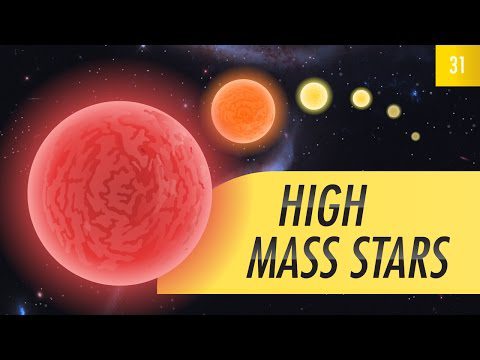Stelele masive fuzionează elemente mai grele în nucleele lor decât stelele cu masă mai mică. Acest lucru duce la crearea de elemente mai grele până la fier. Fierul fură energia critică din miez, făcându-l să se prăbușească. Unda de șoc, împreună cu un roi uriaș de neutrini, explodează prin straturile exterioare ale stelei, făcând-o să explodeze. Supernova rezultată creează și mai multe elemente grele, împrăștiindu-le prin spațiu. De asemenea, din fericire, nu suntem în pericol de la o supernova din apropiere.
Consultați posterul despre sistemul solar Crash Course Astronomy aici: http://store.dftba.com/products/crashcourse-astronomy-poster
—
capitole:
Introducere: High Mass Stars 00:00
Core Fusion creează elemente mai grele 0:51
Alte etape ale Stelelor de mare masă 2:22
Silicon & Iron Fusion 3:43
Colapsul miezului 6:20
Rămășițele Supernovai 8:22
Nucleosinteză explozivă 9:50
Revizuire 11:04
—
PBS Digital Studios: http://youtube.com/pbsdigitalstudios
Urmărește-l pe Phil pe Twitter: https://twitter.com/badastronomer
Doriți să găsiți Crash Course în altă parte pe internet?
Facebook – http://www.facebook.com/YouTubeCrashCourse
Twitter – http://www.twitter.com/TheCrashCourse
Tumblr – http://thecrashcourse.tumblr.com
Asistență CrashCourse pe Patreon: http://www.patreon.com/crashcourse
—
FOTOGRAFII/VIDEOCLIPURI
Suflarea bulelor http://chandra.harvard.edu/resources/animations/pne.html [credit: NASA/CXC/April Jubett]
Dimensiunile stelelor http://www.eso.org/public/images/eso1030c/ [credit: ESO/M. Kornmesser]
Giganți roșii https://commons.wikimedia.org/wiki/File:Redgiants.svg [credit: Wikimedia Commons]
Alfa Orion http://imgsrc.hubblesite.org/hu/db/images/hs-1996-04-a-print.jpg [credit: A. Dupree (CfA), NASA, ESA]
Sun și VY Canis Majoris https://commons.wikimedia.org/wiki/File:Sun_and_VY_Canis_Majoris.svg [credit: Wikimedia Commons]
Nebuloasa cap de vrăjitoare și Rigel http://www.deepskycolors.com/archive/2009/11/16/witch-Head-Nebula-and-Rigel.html [credit: Rogelio Bernal Andreo]
Straturi ale unei stele masive https://www.cursuriaz.ro/wp-content/uploads/localimages/File-3AMassive_star_cutaway_pre-collapse_-28pinned-2C_8M-252B-29.png [credit: Wikimedia Commons]
Swift de la NASA dezvăluie un nou fenomen într-o stea cu neutroni http://www.nasa.gov/mission_pages/swift/bursts/new-phenom.html#.VcvAYflVhBd [credit: NASA’s Goddard Space Flight Center]
Ce este o gaură neagră? http://www.nasa.gov/audience/forstudents/k-4/stories/nasa-knows/what-is-a-black-hole-k4.html [credit: NASA/CXC/M.Weiss]
Moartea Stelelor http://www.spacetelescope.org/videos/hubblecast52a/ [credit: ESA/Hubble]
Mozaic uriaș al Nebuloasei Crabului http://www.nasa.gov/multimedia/imagegallery/image_feature_460.html [credit: NASA, ESA, J. Hester (Arizona State University)]
Hubble și Chandra observă o baltă cerească http://www.spacetelescope.org/images/heic1018b/ [credit: NASA, ESA, the Hubble Heritage Team (STScI/AURA), and NASA/CXC/SAO/J. Hughes]
Vela Supernova Remnant http://www.glitteringlights.com/Images/Nebulae/i-pqWFzmt/O [credit: Marco Lorenzi]
Spica [credit: Phil Plait]
Cassiopeia A https://www.cursuriaz.ro/wp-content/uploads/localimages/a-3ECassiopeia_A_Spitzer_Crop.jpg [credit: Oliver Krause (Steward Observatory) George H. Rieke (Steward Observatory) Stephan M. Birkmann (Max-Planck-Institut fur Astronomie) Emeric Le Floc’h (Steward Observatory) Karl D. Gordon (Steward Observatory) Eiichi Egami (Steward Observatory) John Bieging (Steward Observatory) John P. Hughes (Rutgers University) Erick Young (Steward Observatory) Joannah L. Hinz (Steward Observatory) Sascha P. Quanz (Max-Planck-Institut fur Astronomie) Dean C. Hines (Space Science Institute)]
Sloshing Supernova http://svs.gsfc.nasa.gov/cgi-bin/details.cgi?aid=11735 [credit: NASA’s Goddard Space Flight Center Video and images courtesy of NASA/JPL-Caltech]
Star Burst http://svs.gsfc.nasa.gov/cgi-bin/details.cgi?aid=11447 [credit: NASA’s Goddard Space Flight Center Video courtesy of ESA/Hubble/L. Calcada]
Cursuri interesante:
- Clustere stelare: Astronomie de curs accidental #35
- Stele cu masă scăzută: Astronomie de curs accidental #29
- Stele binare și multiple: Crash Course Astronomy #34
- Neutron Stars: Crash Course Astronomie #32
- Stars: Crash Course Astronomy #26
- Observații cu ochiul liber: Astronomie de curs accidental #2
- Luna: Crash Course Astronomie #12
- Dark Matter: Crash Course Astronomy #41
- Exoplanetele: curs accidental de astronomie #27
- Black Holes: Crash Course Astronomy #33

Onions!!
Supernova are so interesting
"relax, something else will kill you!"
love this series
In a way all of us are post martem legacy of a giant star
Phil… What an absolute Legend.
Your astronomy/ cosmology series is outstanding, Dr. Phil. You provide a wonderful information in an interesting and easy to comprehend manner and your delivery is impecable. Thank you for sharing such interesting information and for making knowledge of science fun and entertaining. You're the best!
are you telliing me we can fuse neon to make oxygen and then we can defuse the sillicon to get even more oxygen wowwwww
so stars have oxygen
I thought neutron star collisions is where most of this material comes from not super novae is this a new thing since this video was out or am I wrong?
You should do a vid on one of the rarest types of stars;
Yellow Hypergiants specifically HR5171a its slightly bigger than Betelguese but its yellow
Pretty cool right
Thanks! But I get really tired of having to translate words, talking heads, and hand waving into models that contain ALL the information and processes you describe. I do not want entertainment, rather tools to help remember and explore all that is possible, all that really happens, or could happen. Richard Collins, The Internet Foundation
Is it really that unlikely that Earth will be affected by a nearby supernova? I've heard that they found the iron isotopes from supernova remnants on Earth and the Moon, indicating that we had actually been blanketed by supernova remnants from more than one supernova in the last 10 million years. The most recent one may have occurred while humans were on the planet, and had huge consequences for us back then. It seems a lot less unlikely when you consider that we may have already had to deal with it once in our species' history.
So we are the child of the stars…..